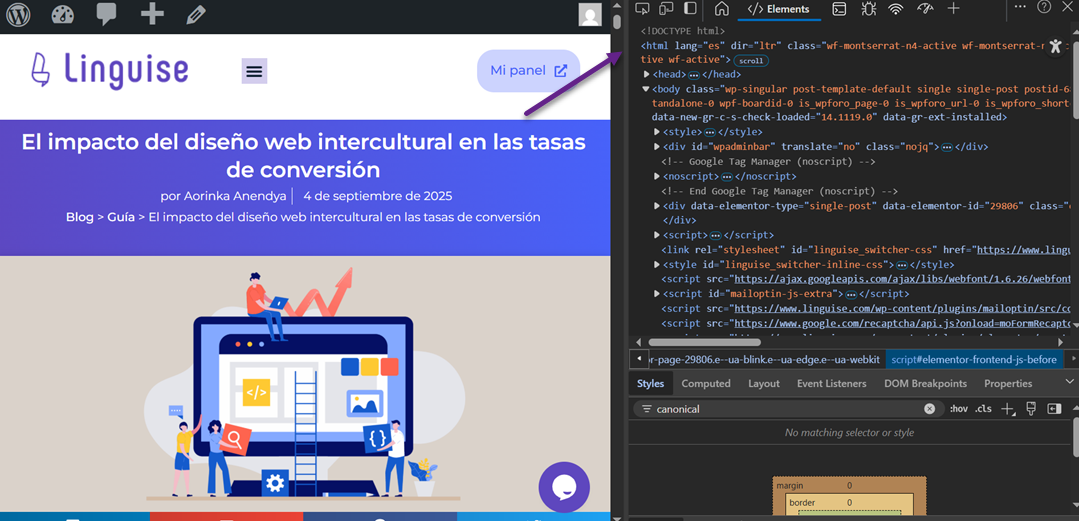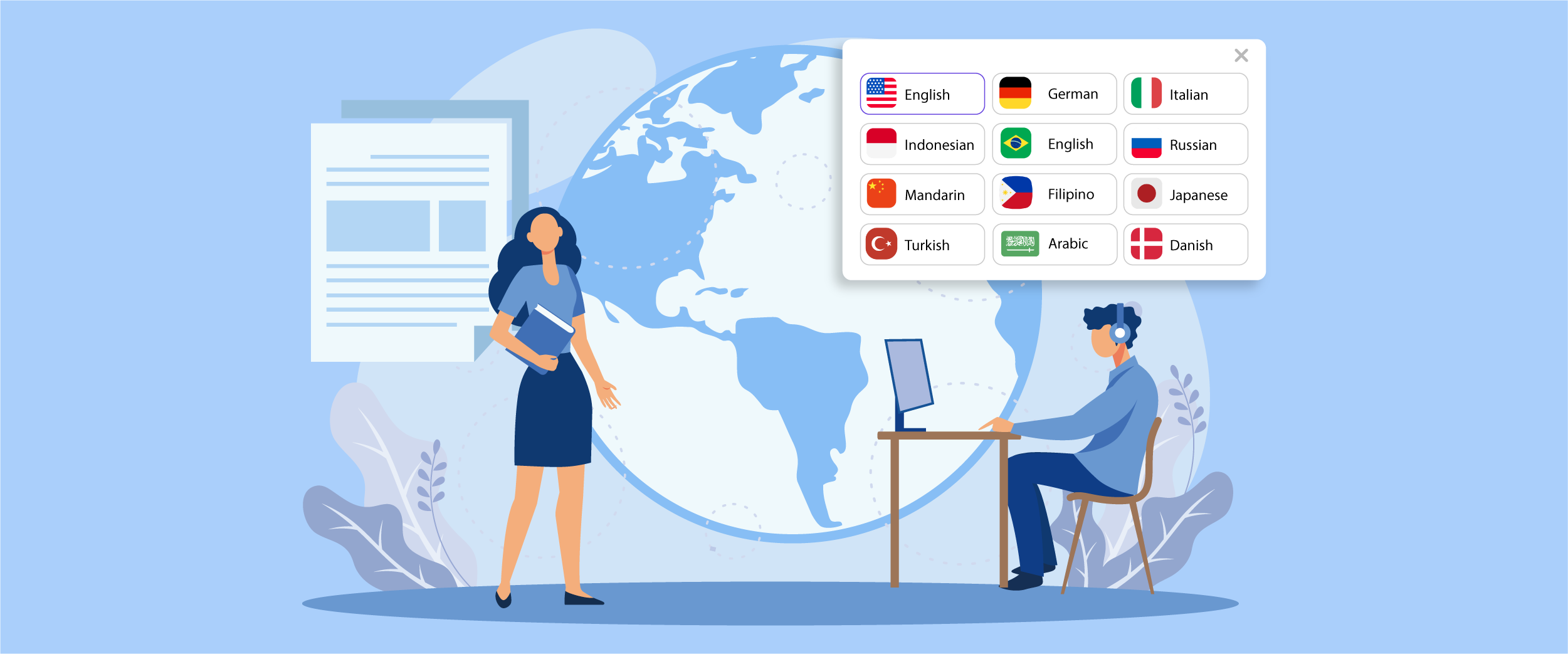ADA and WCAG accessibility compliance for multilingual websites ensures that everyone, including people with disabilities, can access information easily. Compliance with digital accessibility standards helps websites become more inclusive, expands audience reach, and reduces legal risks that could harm businesses and organizations.
This comprehensive guide will discuss how to ensure multilingual websites meet global accessibility standards. It will start by explaining international regulations and the technical steps to implement WCAG 2.1 AA and then proceed to the testing process with assistive technology in various locations so that your website is truly ready to provide an equal digital experience for all users.
Why is digital accessibility as critical as legal translation?

Translating a website into multiple languages is essential for reaching global markets, but ensuring digital accessibility is equally important. If translation guarantees that the message is understood, accessibility ensures everyone can access and interact with the content without barriers.
- Equal access: Just as legal documents must be translated so all parties can understand them, websites must be designed to be accessible to everyone, including users with visual, auditory, or motor impairments.
- Legal compliance: Global regulations such as ADA, EAA, and AODA require websites to be accessible. Ignoring these requirements is as risky as mistranslating legal documents, which may result in penalties or lawsuits.
- Trust and reputation: Companies prioritizing accessibility are seen as more inclusive and responsible. Just as accurate legal translation builds credibility, strong digital accessibility enhances brand reputation in the eyes of global audiences.
- Wider market opportunities: A multilingual and accessible website can reach a broader user base. This meets compliance requirements and opens new business opportunities by expanding potential customers.
Global accessibility laws and multilingual considerations

When creating a multilingual website, compliance doesn’t stop at accurate translation. Website owners must also be aware of accessibility regulations that vary across regions. These laws are designed to ensure people with disabilities have equal access to digital content, and failing to comply can lead to legal, financial, and reputational risks. Let’s look at the major regulations and their implications for multilingual websites.
Americans with Disabilities Act (ADA)
The ADA is one of the most recognized accessibility laws in the United States. Originally focused on physical spaces, it has since been interpreted to cover digital environments, including websites and mobile apps. Businesses that provide services or products to U.S. customers must ensure their online platforms are accessible to people with disabilities. This includes features like alternative text for images, keyboard navigation, and compatibility with screen readers.
For multilingual websites, the ADA implies that accessibility must apply equally across all language versions. For example, if a retail website offers English and Spanish options, both versions should allow screen readers to interpret product descriptions and checkout forms without error. Failure to maintain equal accessibility may result in lawsuits, financial penalties, and loss of customer trust.
European Accessibility Act (EAA)
The EAA was introduced to create consistent accessibility requirements across the European Union. It applies not only to public-sector websites but also to many private-sector services, such as banking, e-commerce, and transportation. The law is built on WCAG standards, requiring compliance with key accessibility features like clear navigation structures, adequate color contrast, and descriptive labels for interactive elements.
For multilingual sites in Europe, this means every language version must be equally accessible. An e-commerce store offering German, French, and Italian content cannot prioritize accessibility in one language while neglecting another. For instance, if alternative text is available for product images in German, it must also be provided in French and Italian. Non-compliance risks not only fines but also restrictions on entering or operating within EU markets.
Accessibility for Ontarians with Disabilities Act (AODA)
In Canada, the AODA sets accessibility requirements specifically for Ontario, one of the country’s largest provinces. The law applies to both public and private organizations and emphasizes inclusivity for people with disabilities. Websites must follow WCAG 2.0 or higher, ensuring content is perceivable, operable, understandable, and robust for all users.
A unique challenge in Canada is the requirement to provide accessibility in both of its official languages, English and French. This means that a government portal or business website serving Ontario residents must ensure users with visual impairments can navigate equally well in either language. For example, a French-speaking user using a screen reader should experience the same ease of navigation as an English-speaking user. Organizations that fail to comply with AODA can face audits, fines, and reputational damage.
Additional regional regulations
Beyond North America and Europe, accessibility laws are gaining traction worldwide. Japan has established JIS X 8341, Korea follows KWCAG, and Australia enforces WCAG compliance for government websites. These standards reflect each region’s cultural and linguistic context while aligning with global accessibility goals. For companies operating internationally, this means adapting to different languages and specific regional compliance frameworks.
Regional differences can create unique challenges for multilingual websites. A Japanese e-learning platform, for example, must support vertical text rendering for accessibility, while a Chinese news site must ensure compatibility with local screen readers that interpret complex character sets. Ignoring these local requirements could limit market reach and create barriers for users in specific regions, even if the website is technically compliant in other countries.
Implementing WCAG 2.1 AA across language versions

WCAG 2.1 AA, or Web Content Accessibility Guidelines Level AA, is the globally recognized standard for making websites accessible to people with disabilities. It focuses on ensuring content is perceivable, operable, understandable, and robust for all users. Level AA is often considered the baseline for legal compliance in many regions because it balances practicality and inclusivity, requiring websites to meet key accessibility features without being overly complex or costly.
Below are the essential steps to ensure accessibility is consistently applied across all site language versions.
Core principles of WCAG (POUR)
The foundation of WCAG 2.1 is built on four principles: Perceivable, Operable, Understandable, and Robust (POUR). Perceivable means that users must be able to experience content through their senses, such as seeing or hearing. Operable ensures all functionality is available via different input methods, like a keyboard. Understandable focuses on presenting content clearly, while Robust ensures compatibility with assistive technologies like screen readers.
For multilingual websites, applying POUR means more than just checking boxes—it’s about maintaining consistency across languages. For example, a navigation menu in English should be just as operable in Arabic, even if the reading direction is different. Similarly, instructions or error messages should remain understandable after translation so users with disabilities are not confused.
Semantic HTML and ARIA in multilingual contexts
Semantic HTML is one of the simplest yet most effective ways to achieve accessibility. Semantic elements like <header>, <nav>, and <footer> provide structure that screen readers can interpret easily. Adding ARIA (Accessible Rich Internet Applications) labels further enhances understanding, especially for dynamic content like forms or interactive widgets.
Proper use of the lang attribute is critical in multilingual websites. This tells assistive technologies which language is being used, ensuring accurate pronunciation by screen readers. For example, a bilingual site with English and Spanish sections should apply lang=”en” and lang=”es” accordingly. Users relying on assistive tools may hear jumbled or incorrect speech output without this.

Color, typography, and script considerations
WCAG 2.1 AA requires sufficient color contrast between text and background to make content readable for users with visual impairments. Typography also plays an important role, ensuring text can be resized or scaled without breaking layout. This must be applied consistently across different writing systems for multilingual sites, from Latin and Cyrillic alphabets to non-Latin scripts like Arabic, Hindi, or Chinese.
A practical example is ensuring that Arabic text, which reads right-to-left, maintains proper line spacing and contrast. Similarly, Japanese text often uses different character densities that require careful typographic choices. By testing color and font rendering across multiple languages, designers can guarantee readability and inclusivity for diverse users.
Keyboard navigation and focus management
Many users with disabilities rely on keyboard navigation instead of a mouse. WCAG 2.1 AA requires websites to allow full functionality using just the keyboard, including menus, forms, and interactive elements. Focus management is also crucial, users should always see where they are on the page when navigating.
In multilingual contexts, keyboard shortcuts and tab orders should remain intuitive even if the language changes. For instance, a French version of a website must provide the same logical navigation flow as the English version. Without proper focus management, users might get lost or stuck while navigating, creating significant barriers to accessibility.
Alternative text and media descriptions
Providing alternative text (alt text) for images and captions for videos is a core WCAG requirement. These elements ensure that users who cannot see or hear media can still understand the content. For multilingual sites, alt text and captions must be translated so that users in every locale receive the same level of information.
For example, if a product image on an e-commerce site has descriptive alt text in English, the Spanish version of the site should provide the same description in Spanish. Similarly, video tutorials must include translated captions or transcripts. Without this, non-English users with disabilities may lose access to vital information.
Integration with translation workflows
Accessibility should be integrated directly into the translation process. This means ensuring that labels, alt text, error messages, and ARIA descriptions are included in translation files. Translators should also be trained to preserve accessibility markers while adapting the text to cultural and linguistic nuances.
For instance, a multilingual e-learning platform must make sure that quiz instructions and feedback messages are both translated and accessible. If accessibility attributes are lost during translation, the localized version of the site may no longer comply with WCAG 2.1 AA. Collaboration between developers, translators, and accessibility testers is essential to prevent such issues.
To make this process more efficient, translation tools must support accessibility attributes like ARIA labels, alt text, and error messages. Linguise, for example, integrates these elements directly into the translation workflow, ensuring that accessibility is not lost during website localization.
Assistive-technology testing workflows in each locale

Accessibility compliance doesn’t stop once WCAG standards are implemented. Real users depend on assistive technologies, such as screen readers and braille displays, to navigate websites—and these tools can behave differently depending on the language. Below are key areas to cover when designing multilingual testing workflows.
Screen reader compatibility across languages
Screen readers like JAWS, NVDA, and VoiceOver are widely used in English-speaking contexts, but other regions rely on localized tools such as NVDA in Chinese or TalkBack in Arabic. Each tool has its quirks, especially when dealing with non-Latin scripts. Testing across different screen readers ensures that content is read out correctly in every language version of a site.
For example, an English website might pass accessibility checks with NVDA, but its Japanese version could struggle if vertical text or ruby annotations are not properly coded. By testing both versions with the appropriate screen readers, developers can guarantee that users in both regions enjoy a smooth and accessible experience.
Voice navigation and input methods
Voice navigation allows users to interact with websites through spoken commands. While effective in English, localized voice commands may differ significantly across languages. Testing voice navigation in multiple languages ensures users can activate menus, submit forms, or search content without friction.
Consider a Spanish-language banking app where a user says “abrir cuenta” (“open account”). If the interface only recognizes the English command “open account,” the voice navigation will fail, creating a major barrier. Testing with localized commands prevents this and ensures inclusivity across languages.
Braille displays and alternative outputs
Some users rely on refreshable braille displays, which convert text on a screen into braille output. These devices must handle multiple languages and scripts correctly, whether that’s English contractions, French accents, or Japanese kana. Testing ensures that localized text displays properly without losing meaning.
For instance, a French news site may show accented words like “économie” incorrectly if braille translation tables are not configured. Similarly, a Chinese website may lose meaning if simplified characters are not mapped properly. Testing each language with real braille devices helps confirm that users with visual impairments receive accurate information.
Real-user testing in each locale
Automated testing tools are valuable but cannot replace human judgment. Real users with disabilities should be involved in testing each localized version of a website. Their feedback uncovers issues that machines often overlook, such as confusing navigation, culturally inappropriate design choices, or poor translation of accessibility statements.
For example, a government site in Canada may pass automated checks in both English and French. Still, French-speaking users with disabilities might report that navigation terms feel unnatural or misleading. By including local users in testing workflows, organizations can refine their accessibility strategies to better match real-world needs.
While real-user testing is essential, the quality of accessibility also depends on how well translations align across languages. By using Linguise, teams can ensure that translated content remains consistent and accessible, reducing the risk of errors that might otherwise appear during user testing.
Localized accessibility statements and compliance documentation
Translating these statements is not enough when operating in multiple languages and regions. They must be carefully localized to reflect regional laws, cultural expectations, and the specific assistive technologies users depend on.
Without localized statements and compliance documentation, organizations risk leaving users uncertain about their rights or unaware of available accessibility features. By tailoring accessibility communication for each locale, businesses meet regulatory obligations and build trust with global users.
Adapting to regional accessibility laws
Different countries enforce different accessibility standards. For example, the U.S. follows the Americans with Disabilities Act (ADA) and Section 508, while the EU adheres to the European Accessibility Act, and Canada enforces the Accessible Canada Act. Localizing compliance statements ensures alignment with regional regulations rather than relying solely on international WCAG guidelines.
This adaptation is vital for credibility. If a German e-commerce site only lists WCAG compliance but ignores the EU’s legal requirements, it may face legal risks. By explicitly referencing regional laws in the localized accessibility statement, the business demonstrates a commitment to both compliance and user rights.
Communicating accessibility features clearly
An accessibility statement should explain which features are available to support users, such as keyboard navigation, screen reader compatibility, or color contrast adjustments. Simply translating this information word-for-word may lead to confusion, especially if local users rely on different terminology for assistive technologies.
For instance, Japanese users might look for references to specific screen readers like PC-Talker, while U.S. users expect mentions of JAWS or NVDA. By customizing the terminology and examples in each locale, businesses make their accessibility features more relatable and useful to users.
Providing contact information and feedback channels
A strong accessibility statement includes clear contact details for reporting issues or requesting accommodations. In a multilingual environment, these channels must be accessible in every supported language to ensure that all users can provide feedback without barriers.
For example, a Spanish-language site that only offers an English contact form discourages Spanish speakers from reporting accessibility problems. Organizations foster inclusivity by providing localized feedback forms and support channels and show that they value user input across regions.
Maintaining updated documentation across locales
Accessibility is an ongoing process; documentation must be regularly updated as standards evolve and websites change. In a multilingual context, it’s important to update all localized versions simultaneously so that users in one region are not left with outdated or inaccurate information.
Consider a case where the English accessibility statement reflects the latest WCAG 2.2 guidelines, but the French version still references WCAG 2.0. This inconsistency could create confusion and erode user trust. A synchronized documentation workflow ensures that all users, regardless of language, have access to accurate and current accessibility information.
Toolchain and processes for ongoing multilingual accessibility audits

Accessibility compliance isn’t a one-time achievement; it’s an ongoing commitment. Websites are constantly evolving with new content, features, and design updates, and each change carries the risk of introducing accessibility issues. For multilingual websites, this challenge multiplies, as every localized version must remain aligned with accessibility standards.
Organizations need a clear toolchain and repeatable processes for continuous auditing to manage this effectively. Combining automated checks with manual reviews, supported by regional expertise, ensures that accessibility standards are consistently met across all languages and locales.
Leveraging automated accessibility testing tools
Automated tools such as Axe, WAVE, and Lighthouse are effective for detecting common accessibility issues like missing alt text, insufficient color contrast, or improper heading structures. These tools can be integrated directly into the development pipeline to flag issues before updates go live.
However, automation has limits. For example, while a tool can detect if an image lacks alt text, it cannot determine whether the description is accurate in each language. This means automation should serve as a first filter, with human reviewers ensuring context and cultural accuracy.
Conducting manual and assistive-technology reviews
Manual testing is crucial for identifying issues that automated tools miss, particularly regarding user experience. This includes testing with screen readers, voice commands, and keyboard navigation to ensure real-world accessibility. Native speakers should test each language version to account for linguistic and cultural nuances.
For instance, keyboard navigation might work perfectly in English but fail in an Arabic version if right-to-left text direction isn’t properly supported. Manual reviews ensure that such issues are caught and resolved before they affect users.
Establishing regular audit cycles
Accessibility audits should not be one-off projects. Setting regular audit cycles, such as quarterly or biannual reviews, helps ensure compliance remains up-to-date. These cycles should cover all language versions, with clear checklists for automated scans and manual usability tests.
For example, a multilingual e-commerce platform might schedule quarterly audits across English, Spanish, and Japanese sites. This ensures that updates to product pages, checkout flows, or multimedia elements don’t inadvertently break accessibility in any locale.
Building a centralized accessibility dashboard
To manage audits effectively across multiple locales, organizations can develop a centralized accessibility dashboard. This dashboard consolidates results from automated scans, manual testing, and regional audits, making it easier for teams to track progress and spot recurring issues.
A global dashboard also fosters accountability. For instance, if multiple regions repeatedly fail captioning standards, this trend can be flagged and addressed with targeted training or updated guidelines. Such visibility ensures that accessibility remains a priority across the organization.
Conclusion
Ensuring ADA and WCAG accessibility compliance for multilingual websites is not just about meeting regulations, it’s about creating equal digital experiences for all users. From understanding global accessibility laws to implementing WCAG 2.1 AA and conducting localized assistive technology testing, every step strengthens inclusivity while protecting businesses from legal and reputational risks. When websites remain accessible across all languages, they become more trustworthy, user-friendly, and globally competitive.
To simplify this process, use tools like Linguise can help integrate accessibility considerations into multilingual workflows by ensuring translated content, alt text, and navigation remain consistent across languages. With Linguise, you can build websites that are not only multilingual but also accessible, helping your business reach wider audiences while staying fully compliant.




